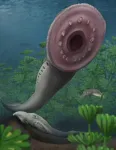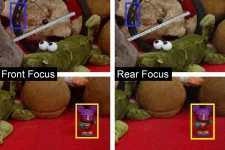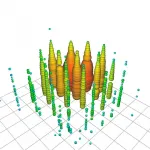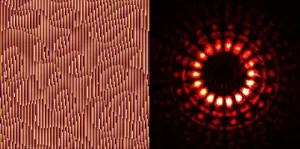(Press-News.org) Scientists have developed a see-through glass display with a high white light contrast ratio that smoothly transitions between a broad spectrum of colors when electrically charged. The technology, from researchers at Jilin University in Changchun, China, overcomes limitations of existing electrochromic devices by harnessing interactions between metal ions and ligands, opening the door for numerous future applications. The work appears March 10 in the journal Chem.
"We believe that the method behind this see-through, non-emissive display may accelerate the development of transparent, eye-friendly displays with improved readability for bright working conditions," says Yu-Mo Zhang, an associate professor of chemistry at Jilin University and an author on the study. "As an inevitable display technology in the near future, non-emissive see-through displays will be ubiquitous and irreplaceable as a part of the Internet of Things, in which physical objects are interconnected through software."
With the application of voltage, electrochromic displays offer a platform in which light's properties can be continuously and reversibly manipulated. These devices have been proposed for use in windows, energy-saving electronic price tags, flashy billboards, rearview mirrors, augmented virtual reality, and even artificial irises. However, current models come with limitations--they tend to have low contrast ratios, especially for white light, poor stability, and limited color variations, all of which have prevented electrochromic displays from reaching their technological potential.
To overcome these deficiencies, Yuyang Wang and colleagues developed a simple chemical approach in which metal ions induce a wide variety of switchable dyes to take on particular structures, then stabilize them once they have reached the desired configurations. To trigger a color change, the electrical field is simply applied to switch the metal ions' valences, forming new bonds between the metal ions and molecular switches.
"Differently from the traditional electrochromic materials, whose color-changing motifs and redox motifs are located at the same site, this new material is an indirect-redox-color-changing system composed by switchable dyes and multivalent metal ions," says Zhang.
To test this approach, the researchers fabricated an electrochromic device by injecting a material containing metal salts, dyes, electrolytes, and solvent into a sandwiched device with two electrodes and adhesive as a spacer. Next, they performed a battery of light spectrum and electrochemical tests, finding that the devices could effectively achieve cyan, magenta, yellow, red, green, black, pink, purple, and gray-black displays, while maintaining a high contrast ratio. The prototype also shifted seamlessly from a colorless, transparent display to black--the most useful color for commercial applications - with high coloration efficiency, low transmittance change voltage, and a white light contrast ratio that would be suitable for real transparent displays.
"The low cost and simple preparation process of this glass device will also benefit its scalable production and commercial applications," notes Zhang.
Next, the researchers plan to optimize the display's performance so that it may quickly meet the requirements of high-end displays for real-world applications. Additionally, to avoid leakage from its liquid components, they plan to develop improved fabrication technologies that can produce solid or semi-solid electrochromic devices.
"We are hoping that more and more visionary researchers and engineers cooperate with each other to optimize the electrochromic displays and promote their commercialization," says Zhang.
INFORMATION:
The authors received financial support from the National Natural Science Foundation of China.
Chem, Wang et al.: "A see-through electrochromic display via dynamic metal-ligand interactions"
https://www.cell.com/chem/fulltext/S2451-9294(21)00055-3
Chem (@Chem_CP) is the first physical science journal published by Cell Press. A sister journal to Cell, Chem, which is published monthly, provides a home for seminal and insightful research and showcases how fundamental studies in chemistry and its sub-disciplines may help in finding potential solutions to the global challenges of tomorrow. Visit: http://www.cell.com/chem. To receive Cell Press media alerts, contact press@cell.com.
The cryptocurrency market has been abuzz as Bitcoin gains popularity with investors, reaching an all-time high of over $58,000 apiece in February. In a commentary published March 10 in the journal Joule, financial economist Alex de Vries quantifies how the surging Bitcoin price is driving increasing energy consumption, exacerbating the global shortage of chips, and even threatening international safety.
Theoretically, any computer with access to the internet and electricity can "mine" Bitcoin, a process to receive cryptocurrency by solving sophisticated mathematical equations. It is estimated that all miners combined make over 150 quintillion--that is 18 zeros following 150--attempts every second to solve the equation, according to numbers from January 11, 2021. Computational power ...
Scientists and healthcare providers are beginning to use a new approach for assessing a person's inherited risk for diseases like Type 2 diabetes, coronary heart disease and breast cancer, which involves calculating a END ...
When we think about the causes of neurological disorders and how to treat them, we think about targeting the brain. But is this the best or only way? Maybe not. New research by scientists at Baylor College of Medicine suggests that microbes in the gut may contribute to certain symptoms associated with complex neurological disorders. The findings, published in the journal Cell, also suggest that microbe-inspired therapies may one day help to treat them.
Dr. Mauro Costa-Mattioli, professor and Cullen Foundation Endowed Chair in neuroscience and director of the Memory and Brain Research Center at Baylor, discovered ...
Ottawa, March 10, 2021 - A new study of fossilized lampreys dating from more than 300 million years ago is challenging a long-held theory about the evolutionary origin of vertebrates (all animals with a backbone). The findings are published March 10 in the science journal Nature.
Lampreys are ancient, jawless, eel-like fishes that arose around half a billion years ago and they have long provided insights into vertebrate evolution. Now, scientists with the Canadian Museum of Nature, the University of Chicago and the Albany Museum in South Africa are reporting their analysis of dozens of tiny fossils that track the life stages and growth of ancient lampreys, from hatchlings to juveniles to adults.
Their results counter the established view that the blind, filter-feeding ...
A new study out of the University of Chicago, the Canadian Museum of Nature and the Albany Museum challenges a long-held hypothesis that the blind, filter-feeding larvae of modern lampreys are a holdover from the distant past, resembling the ancestors of all living vertebrates, including ourselves. The new fossil discoveries indicate that ancient lamprey hatchlings more closely resembled modern adult lampreys, and were completely unlike their modern larvae counterparts. The results were published on March 10 in Nature.
Lampreys -- unusual jawless, eel-like, creatures -- have long provided insights ...
Despite years of hype, virtual reality headsets have yet to topple TV or computer screens as the go-to devices for video viewing. One reason: VR can make users feel sick. Nausea and eye strain can result because VR creates an illusion of 3D viewing although the user is in fact staring at a fixed-distance 2D display. The solution for better 3D visualization could lie in a 60-year-old technology remade for the digital world: holograms.
Holograms deliver an exceptional representation of 3D world around us. Plus, they're beautiful. (Go ahead -- check out the holographic dove on your Visa card.) Holograms offer a shifting perspective based on the viewer's position, and they allow the eye to adjust focal depth to alternately focus on foreground and background.
Researchers have long sought ...
On December 6, 2016, a high-energy particle called an electron antineutrino hurtled to Earth from outer space at close to the speed of light carrying 6.3 petaelectronvolts (PeV) of energy. Deep inside the ice sheet at the South Pole, it smashed into an electron and produced a particle that quickly decayed into a shower of secondary particles. The interaction was captured by a massive telescope buried in the Antarctic glacier, the IceCube Neutrino Observatory.
IceCube had seen a Glashow resonance event, a phenomenon predicted by Nobel laureate physicist ...
Researchers have struck quantum gold--and created a new word--by enlisting machine learning to efficiently navigate a 20-dimensional quantum treasure map.
Physicist Dr Markus Rambach from the ARC Centre of Excellence for Engineered Quantum Systems (EQUS) at The University of Queensland said the team was able to find unknown quantum states more quickly and accurately, using a technique called self-guided tomography.
The team also introduced the 'quvigint', which is like a qubit (the quantum version of a classical bit that takes on the values '0' or '1') except that it takes on not two, but 20 possible values.
Dr ...
What The Study Did: In this study, most risk factors associated with SARS-CoV-2 infection among health care workers were outside the workplace.
Authors: Jesse T. Jacob, M.D., of Emory University in Atlanta, is the corresponding author.
To access the embargoed study: Visit our For The Media website at this link https://media.jamanetwork.com/
(doi:10.1001/jamanetworkopen.2021.1283)
Editor's Note: The article includes conflict of interest and funding/support disclosures. Please see the article for additional information, including other authors, author contributions and affiliations, conflict of interest and financial disclosures, and funding and support.
INFORMATION:
Media ...
MADISON - On December 6, 2016, a high-energy particle hurtled to Earth from outer space at close to the speed of light. The particle, an electron antineutrino, smashed into an electron deep inside the ice sheet at the South Pole. This collision produced a particle that quickly decayed into a shower of secondary particles, triggering the sensors of the IceCube Neutrino Observatory, a massive telescope buried in the Antarctic glacier.
IceCube had seen a Glashow resonance event, a phenomenon predicted by Nobel laureate physicist Sheldon Glashow in 1960. With this detection, scientists provided another confirmation of the Standard Model of particle physics. It ...




